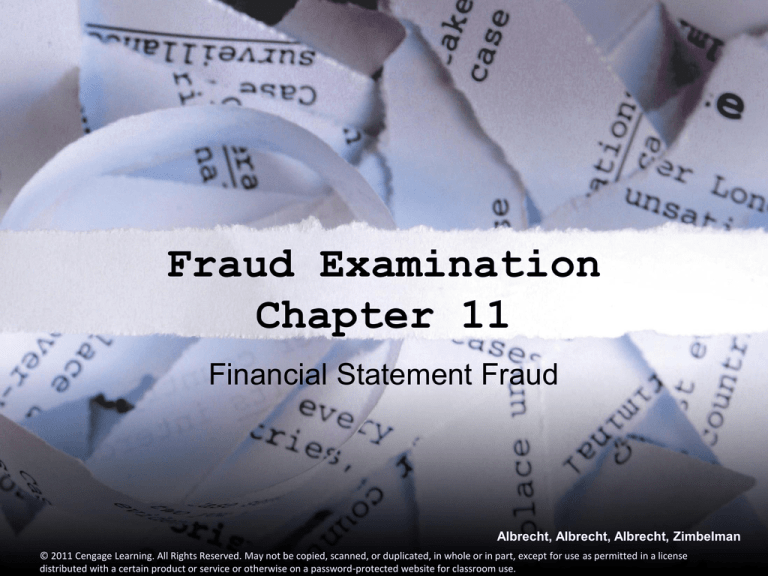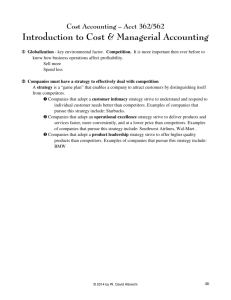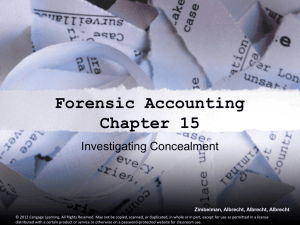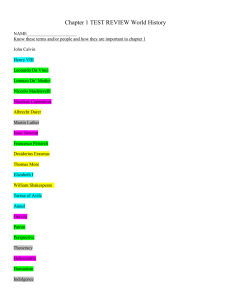
Fraud Examination
Chapter 11
Financial Statement Fraud
Albrecht, Albrecht, Albrecht, Zimbelman
© 2011 Cengage Learning. All Rights Reserved. May not be copied, scanned, or duplicated, in whole or in part, except for use as permitted in a license
distributed with a certain product or service or otherwise on a password-protected website for classroom use.
To the Student
Chapter 11 is the first of three chapters on financial statement fraud,
also known as management fraud. This chapter discusses some of the
numerous financial statement frauds discovered in corporate America
in the last decade.
We discuss the common elements of those frauds and the conditions
that led to the rash of financial statement fraud around the turn of the
new millennium. Financial statement frauds almost always involve
company management and are the result of pressures to meet
internal or external expectations.
This chapter provides a framework for detecting financial statement
fraud, which emphasizes the need to consider the context in which
management is operating and being motivated.
Albrecht, Albrecht, Albrecht, Zimbelman
© 2011 Cengage Learning. All Rights Reserved. May not be copied, scanned, or duplicated, in whole or in part, except for use as permitted in a license
Learning Objectives
Discuss the role that financial statements play in
capital markets.
Understand the nature of financial statement
fraud.
Become familiar with financial statement fraud
statistics.
See how financial statement frauds occur and are
concealed.
Albrecht, Albrecht, Albrecht, Zimbelman
© 2011 Cengage Learning. All Rights Reserved. May not be copied, scanned, or duplicated, in whole or in part, except for use as permitted in a license
Learning Objectives
Outline the framework for detecting financial
statement fraud.
Identify financial statement fraud exposures.
Explain how information regarding a company’s
management and directors, nature of
organization, operating characteristics,
relationship with others, and financial results can
help assess the likelihood of financial statement
fraud.
Albrecht, Albrecht, Albrecht, Zimbelman
© 2011 Cengage Learning. All Rights Reserved. May not be copied, scanned, or duplicated, in whole or in part, except for use as permitted in a license
Financial Statement Fraud
Misstatement of financial statements can result from
manipulating, falsifying, or altering accounting
records.
Misleading financial statements cause serious
problems in the market and the economy.
Often result in large losses for investors, lack of trust
in the market and accounting systems
Albrecht, Albrecht, Albrecht, Zimbelman
© 2011 Cengage Learning. All Rights Reserved. May not be copied, scanned, or duplicated, in whole or in part, except for use as permitted in a license
Elements of the Perfect
Fraud Storm
A Booming Economy
Decay of Moral Values
Misplaced Incentives
High Analysts’ Expectations
High Debt Levels
Focus on Accounting Rules Rather Than
Principles
Lack of Auditor Independence
Greed
Educator Failures
Albrecht, Albrecht, Albrecht, Zimbelman
© 2011 Cengage Learning. All Rights Reserved. May not be copied, scanned, or duplicated, in whole or in part, except for use as permitted in a license
Nature of Financial
Statement Fraud
Involves intentional deceit
Involves attempted concealment
Rarely seen
Many false red flags
Conviction is very difficult
Albrecht, Albrecht, Albrecht, Zimbelman
© 2011 Cengage Learning. All Rights Reserved. May not be copied, scanned, or duplicated, in whole or in part, except for use as permitted in a license
Detecting Financial
Statement Fraud
Strategic Reasoning
Questions to ask:
What types of fraud schemes is management likely to
use to commit financial statement fraud?
What typical tests are used to detect these schemes?
How could management conceal the scheme of interest
from the typical test?
How could the typical test be modified so as to detect
the concealed scheme?
Albrecht, Albrecht, Albrecht, Zimbelman
© 2011 Cengage Learning. All Rights Reserved. May not be copied, scanned, or duplicated, in whole or in part, except for use as permitted in a license
Detecting Financial
Statement Fraud
Financial Statement Analysis
Focus on the changes in reported assets, liabilities,
revenues, and expenses from period to period or by
comparing company performance to industry norms.
Nonfinancial performance measures
Research suggests that auditors, investors,
regulators, or fraud examiners can benefit by using
nonfinancial performance measures to assess the
likelihood of fraud.
Albrecht, Albrecht, Albrecht, Zimbelman
© 2011 Cengage Learning. All Rights Reserved. May not be copied, scanned, or duplicated, in whole or in part, except for use as permitted in a license
Detecting Financial
Statement Fraud
Nonfinancial Performance Measures look for a
discrepancy between the company’s financial and
nonfinancial performance
Example:
Former HealthSouth CEO Richard Scrushy’s
The company’s revenues and assets were increasing
while the number of HealthSouth facilities decreased
Albrecht, Albrecht, Albrecht, Zimbelman
© 2011 Cengage Learning. All Rights Reserved. May not be copied, scanned, or duplicated, in whole or in part, except for use as permitted in a license
Detecting Financial
Statement Fraud
In addition to considering financial and nonfinancial data to
assess fraud risk, auditors can identify fraud risk
exposures
by examining four groups of fraud exposures.
Albrecht, Albrecht, Albrecht, Zimbelman
© 2011 Cengage Learning. All Rights Reserved. May not be copied, scanned, or duplicated, in whole or in part, except for use as permitted in a license









